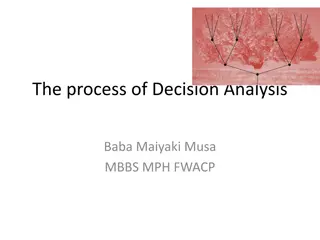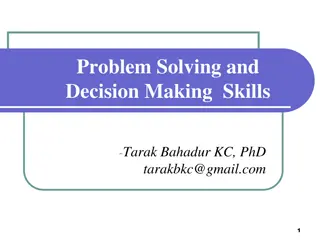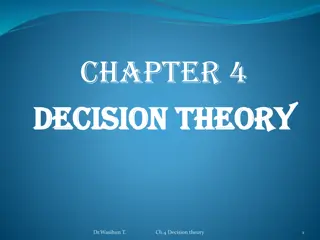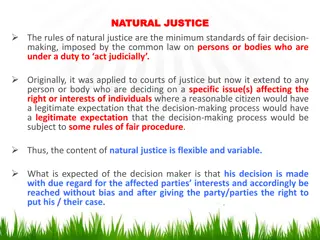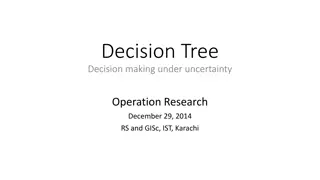Understanding the Decision-Making Process
Decision-making is the process of selecting the best course of action from multiple alternatives to achieve desired outcomes. It involves identifying decisions, gathering relevant information, and following a step-by-step process to make informed choices. Principles and steps like identifying the decision, gathering information, evaluating alternatives, deciding, taking action, and reviewing the decision are crucial for effective decision-making.
Download Presentation

Please find below an Image/Link to download the presentation.
The content on the website is provided AS IS for your information and personal use only. It may not be sold, licensed, or shared on other websites without obtaining consent from the author. Download presentation by click this link. If you encounter any issues during the download, it is possible that the publisher has removed the file from their server.
E N D
Presentation Transcript
Dr Digvijay Sharma School of Health Sciences
Decision making decision-making is all about choosing from the available options. The better choices you make, the better decision-maker you'll become. You have many decision-making examples in daily life such as: Deciding what to wear. Deciding what to eat for lunch.
Definition Decision-making can be defined as the process of selecting a right and effective course of action from two or more alternatives for the purpose of achieving a desired result. Decision-making is the essence of management. A decision is an act of selection or choice of one action from several alternatives.
Definition According to P. F. Drucker Whatever a manager does he does through making decisions. All matters relating to planning, organising, direction, co- ordination and control are settled by the managers through decisions which are executed into practice by the operators of the enterprise. George Terry defines decision-making as the selection of one behaviouralternative from two or more possible alternatives.
Process of decision making Using a step-by-step decision-making process can help you make more deliberate, thoughtful decisions by organizing relevant information and defining alternatives. This approach increases the chances that you will choose the most satisfying alternative possible.
Principles of Decision Making If certain principles are followed for decision-making, such multidimensional reactions can mostly be overcome.
Step 1: Identify the decision You realize that you need to make a decision. Try to clearly define the nature of the decision you must make. This first step is very important.
Step 2: Gather relevant information Collect some pertinent information before you make your decision: what information is needed, the best sources of information, and how to get it. This step involves both internal and external work. Some information is internal: you ll seek it through a process of self-assessment. Other information is external: you ll find it online, in books, from other people, and from other sources.
Step 3: Identify the alternatives As you collect information, you will probably identify several possible paths of action, or alternatives. You can also use your imagination and additional information to construct new alternatives. In this step, you will list all possible and desirable alternatives.
Step 4: Weigh the evidence Draw on your information and emotions to imagine what it would be like if you carried out each of the alternatives to the end. Evaluate whether the need identified in Step 1 would be met or resolved through the use of each alternative. As you go through this difficult internal process, you ll begin to favor certain alternatives: those that seem to have a higher potential for reaching your goal. Finally, place the alternatives in a priority order, based upon your own value system.
Step 5: Choose among alternatives Once you have weighed all the evidence, you are ready to select the alternative that seems to be best one for you. You may even choose a combination of alternatives. Your choice in Step 5 may very likely be the same or similar to the alternative you placed at the top of your list at the end of Step 4.
Step 6: Take action You re now ready to take some positive action by beginning to implement the alternative you chose in Step 5.
Step 7: Review your decision & its consequences In this final step, consider the results of your decision and evaluate whether or not it has resolved the need you identified in Step 1. If the decision has not met the identified need, you may want to repeat certain steps of the process to make a new decision. For example, you might want to gather more detailed or somewhat different information or explore additional alternatives.
Types of Decision making There are three types of decision in business: strategic. tactical. operational.
Strategic decision making A strategic plan supports the organization's vision and mission statements by outlining the high-level plan to achieve both. Strategic plans generally provide the broad, long-term picture. In order to develop strategic plans, top management uses reports on finances, operations and the external environment to project future actions. Strategic plans influence the development of tactical plans.
Strategic decision making Strategic decisions are long-term decisions. These are considered where The future planning is concerned. Strategic decisions are taken in Accordance with organizational mission and vision. These are related to overall Counter planning of all Organization. These deal with organizational Growth.
Tactical Decision making A tactical plan answers "how do we achieve our strategic plan?" It outlines actions to achieve short- term goals, generally within a year or less. They are much narrower in focus and can be broken down into the departmental or unit level. Tactical plans outline what each department needs to achieve, how it must do soand who has the responsibility for implementation.
These are short-term based Decisions. These are taken according to strategic and operational Decisions. These are related to working of employees in an Organization. These are in welfare of employees working in an organization.
Operational decisions Operational decisions are short-term decisions that are made generally weekly, daily, or hourly, focusing mainly on the details of operations, day-to-day resource allocation, details of inventory control, and delivery routing, to ensure the efficiency of operations and an optimized flow of products along the biomass-based production chains. Operational decisions can be revised and adjusted frequently, due to the dynamic structure of internal and external conditions of supply chains and associated activities.
Operational Decisions Operational decisions are not frequently taken. These are medium-period based decisions. These are taken in accordance with strategic and administrative decision. These are related to production. These are related to production and factory growth.
Importance of Descision making
1. Better Utilisation of Resources Decision making helps to utilise the available resources for achieving the objectives of the organisation. The available resources are the 6 Ms, i.e. Men, Money, Materials, Machines, Methods and Markets. The manager has to make correct decisions for all the 6 Ms. This will result in better utilisation of these resources.
2. Facing Problems and Challanges Decision making helps the organisation to face and tackle new problems and challenges. Quick and correct decisions help to solve problems and to accept new challenges.
3. Business Growth Quick and correct decision making results in better utilisation of the resources. It helps the organisation to face new problems and challenges. It also helps to achieve its objectives. All this results in quick business growth. However, wrong, slow or no decisions can result in losses and industrial sickness.
4. Achieving Objectives Rational decisions help the organisation to achieve all its objectives quickly. This is because rational decisions are made after analysing and evaluating all the alternatives.
5. Increases Efficiency Rational decisions help to increase efficiency. Efficiency is the relation between returns and cost. If the returns are high and the cost is low, then there is efficiency and vice versa. Rational decisions result in higher returns at low cost.
6. Facilitate Innovation Rational decisions facilitate innovation. This is because it helps to develop new ideas, new products, new process, etc. This results in innovation. Innovation gives a competitive advantage to the organisation.
7. Motivates Employees Rational decision results in motivation for the employees. This is because the employees are motivated to implement rational decisions. When the rational decisions are implemented the organisation makes high profits. Therefore, it can give financial and non-financial benefits to the employees.
Bibliography https://www.umassd.edu/fycm/decision-making/process/ Priyali Sharma. Decision-Making : Definition, Importance and Principles | Management https://www.managementstudyguide.com/strategic-decisions.htm Gaurav Akran.https://kalyan-city.blogspot.com/2011/08/importance- of-decision-making-in.html






